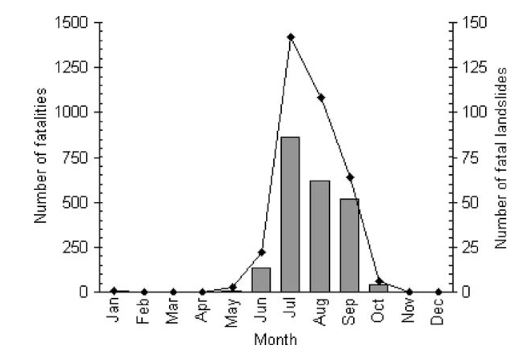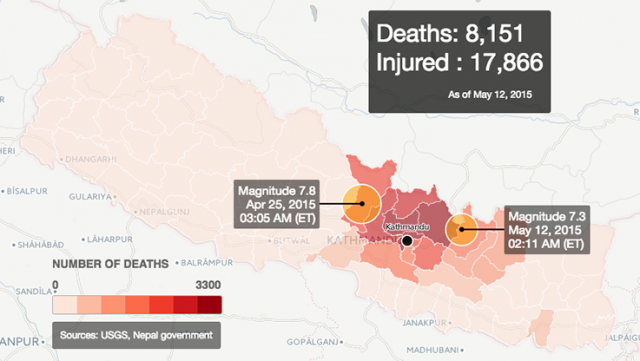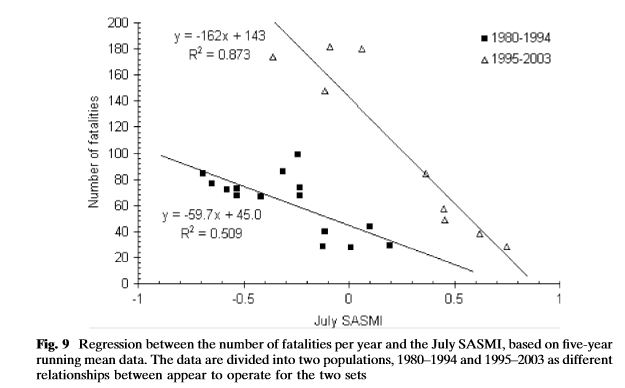18 May 2015
Landslides in Nepal and the impact of the SW Monsoon
Posted by Dave Petley
Landslides in Nepal and the SW Monsoon
As Nepal moves out of the emergency phase of the earthquake disaster and starts to transition into the recovery and reconstruction phases, attention is now turning to the potential impacts of the SW (summer) monsoon period. In particular, there is now real concern that the heavy rainfall that the monsoon brings may reactivate many landslides, and trigger a host of new failures as well. Based on experience from elsewhere, these concerns are valid.
Not entirely coincidentally, back in 2007 I wrote what is perhaps the definitive paper on the triggering of landslides by the monsoon in Nepal, based on a database of landslides that we constructed as part of the DfID Landslide Risk Analysis project. This paper, Petley et al. (2007), is available for download for free from the Natural Hazards journal website.
In the paper we demonstrated three key aspects of landslides in Nepal:
1. The SW Monsoon is the dominant factor:
This graph from my paper shows the monthly occurrence of landslides that cause loss of life in Nepal (the data is for 1978-2005 inclusive):
.
The trend is clear – landslides occur almost solely in the summer period, with low incidence in May, a few more in June (the data show that these are mostly in the last week of the month, and then increasing dramatically in July and remaining high for three months. The threat in the months ahead is clear.
2. The earthquake affected area is extremely landslide-prone:
Map A below shows the distribution of landslides that caused loss of life over the same period, plotted in terms of number of landslides per unit area:
.
Map B is the distribution of rainfall. It is clear that landslides are most serious in a swathe of Hill Districts in Central Nepal. This starts to look deeply worrying when compared with a map of the areas most seriously affected by the earthquake:
.
The coincidence between the area of intense landslides and the area affected by the earthquake is deeply worrying.
3. Nepal landslides are at their worst when the SW Monsoon across the whole region is weak.
This may seem like a perverse relationship, but we found that the worst years for landslides in Nepal occurred in years when the SW Monsoon for the whole region (as indicated by SASMI – an index of monsoon intensity) was low:
.
The reason that the data split into two groups is that the later values (with far higher losses from landslides) occurred after the start of the spate of road building in the mountains of Nepal, after which the occurrence of landslides increased dramatically. So, we might expect the landslide problem in Nepal to be particularly serious this year if the SW Monsoon across the whole region is particularly weak.
The India Meteorological Department has forecast that the SW Monsoon this year will be “below normal”.
Reference
Petley, D.N., Hearn, G.J., Hart, A., Rosser, N.J., Dunning, S.A., Oven, K., and Mitchell, W.A. 2007. Trends in landslide occurrence in Nepal. Natural Hazards 43:23–44. Download the PDF from here (no cost).






 Dave Petley is the Vice-Chancellor of the University of Hull in the United Kingdom. His blog provides commentary and analysis of landslide events occurring worldwide, including the landslides themselves, latest research, and conferences and meetings.
Dave Petley is the Vice-Chancellor of the University of Hull in the United Kingdom. His blog provides commentary and analysis of landslide events occurring worldwide, including the landslides themselves, latest research, and conferences and meetings.